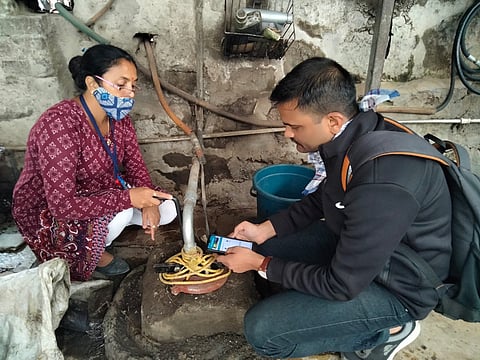

India is grappling with a severe water crisis, and effective groundwater level management has become imperative. The government's role in water resource management is crucial, encompassing water conservation programs, awareness initiatives, policy formulation, and monitoring. However, individual contributions, especially from borewell owners, can significantly impact the overall groundwater scenario.
The Indian government has been at the forefront of water resource management through various initiatives. Programs like the Jal Shakti Abhiyan and the Atal Bhujal Yojana aim to promote water conservation and groundwater recharge. Policies focus on sustainable water use, while awareness campaigns educate the public on the importance of preserving this vital resource. Monitoring mechanisms ensure that these efforts are effective, but challenges remain, particularly in managing private borewells.
Borewell Challenges
Borewells present unique challenges compared to open wells, primarily due to their inaccessibility. Most borewell owners simply switch the pump on and off, with little understanding of the actual water availability. Unlike open wells, where water levels are visible, borewell users gauge water availability based on output flow, which is not a precise method.
Precise information on groundwater levels is scarce, and no simple, user-friendly tools exist to provide this data. This gap in knowledge leads to indiscriminate water pumping, often resulting in borewells running dry. In areas with numerous borewells, this can drastically lower the groundwater table, creating a regional water crisis.
Significant Level Drop
States like Tamil Nadu, Haryana, and Punjab are facing significant drops in groundwater levels. Tamil Nadu relies heavily on groundwater due to limited surface water sources, leading to severe shortages in cities like Chennai. The state has resorted to desalination technology to address the water crisis.
Maharashtra, with 153 drought-affected talukas in 2019, has seen a 1 to 3-meter average drop in groundwater levels over the past five years, with some areas experiencing drops as significant as 10 meters. Efficient use of available groundwater and recharging borewells are essential measures in these regions.
Advanced Technologies
Advanced technologies are transforming groundwater monitoring, offering precise, real-time data and facilitating sustainable water management. Digital groundwater monitoring systems provide continuous data on levels and quality, enabling early issue detection and timely adjustments.
Spatial decision support systems analyze data, simulate management scenarios, and offer strategic recommendations, enhancing decision-making. Remote sensing technologies like satellite imagery monitor groundwater over large areas, identifying usage trends and availability patterns.
Digital groundwater models predict resource responses to different management scenarios and future developments, aiding long-term planning.
Innovative startups are leading this technological advancement. AI and IoT-powered smart devices providing real-time water quality monitoring and corrective measures, or sensors measuring groundwater in tube wells, borewells, and cavity wells, aiming for comprehensive water monitoring, are vital for sustainable groundwater management and preserving resources for future generations.
Simple Solutions
Besides advanced technologies, a few startups are also focussing on using traditional SONAR technique for detecting and determining the distance and direction of underwater objects by acoustic means, to provide precise groundwater level readings. What appeals to the farmers is that this technology does not require AI tools or IoT smart devices, but a simple mobile app which any individual can use.
Vijay Gawade, Founder of one such start-up Waterlab Solutions, says, “Advantage of a simple technology is that farmers or any other individual can just tap the metal cap on the borewell three times with a spanner or iron rod, creating vibrations that generate sound waves. These waves travel down the borewell, hit the water, and produce an echo. The app captures this echo, and within 30 seconds, it provides an accurate water level reading.”
“In about 90 per cent of cases, the echo is successfully generated, offering reliable data to borewell owners. Farmers, who typically know the depth of their borewells, can use this information to estimate the available water column. It is recommended that readings are taken before and after extracting water to track water level changes, helping farmers plan irrigation cycles and crop patterns effectively,” explains Gawade.
Financial Gains for Farmers
Maharashtra has around 44 lakh agricultural pumps, with an estimated 30 lakh being borewells. Providing farmers with a tool to manage these borewells can prevent them from running dry, significantly impacting the groundwater scenario.
In regions like Vidarbha, where 40 per cent of farmers face summer crop losses due to dry borewells, simple technological solutions can help farmers prevent financial losses by enabling better planning. “A survey of 300 farmers done by us has revealed that borewell-related crop losses ranged from Rs 3,000 to Rs 3 lakh. If farmers can adjust their motor pumps and even consider reusing abandoned borewells after checking for recharge, they can prevent most financial losses,” claims Gawade.
Policy Implementation
Implementing policies in critical and semi-critical zones is challenging, but technology can play a pivotal role in reducing groundwater depletion. Government engagement with startups is crucial to create awareness, measure groundwater levels, and develop effective management tools. By empowering farmers with technology, government can ensure sustainable groundwater use and prolong the life of borewells.
Groundwater level management in India is a complex issue that requires coordinated efforts from the government and individual borewell owners. While the government continues to lead with conservation programs and policies, innovative technological solutions offer a practical approach for individuals, especially farmers, to contribute effectively. By managing their borewells, farmers can significantly impact groundwater conservation, ensuring a sustainable water supply for future generations.
Facts
Primary source of replenishable groundwater resources in India is rainfall, accounting for nearly 60 per cent of the total annual groundwater recharge.
Total annual groundwater recharge in India - 449.08 bcm
Annual extractable ground water resource - 407.21 bcm
Annual groundwater extraction (as in 2023) - 241.34 bcm
Average stage of groundwater extraction for India - 59.26 per cent
Source: Dynamic Groundwater Resources of India, 2023
(Compiled by Central Ground Water Board, Department of Water Resources, Ministry of Jal Shakti, Government of India)
